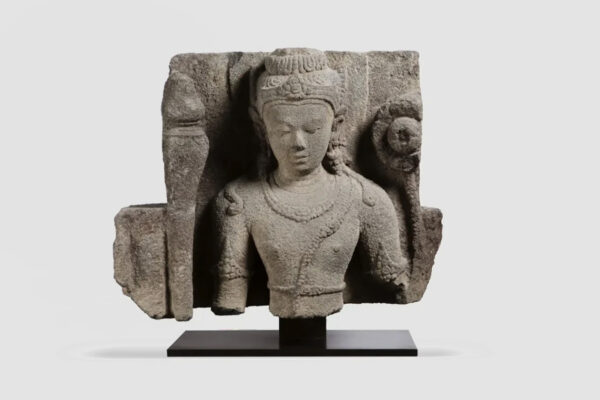Enamel estimate
Do you own an Asian enamel object and would like to know its value? Whether you’re a passionate collector or have a family heirloom, having your enamel object appraised is an essential step in understanding its true potential. Our Asian art experts will provide you with a free, confidential appraisal within 48 hours, assisting you in every step of the way, whether you wish to sell at auction or simply find out the value of your piece.
Estimates and prices of Asian enamels
Asian enamels are highly prized items on today’s art market. Here’s a detailed guide to understanding the value of these pieces and how to recognize them.
Price table for Asian enamel objects
| Typology of Asian enamel objects | Low range (€) | Average range (€) | High range (€) |
|---|---|---|---|
| Enamel and porcelain bottle / jar | 20 – 50 | 1000 – 3 000 | 50 000 – 150 000 |
| Vases in cloisonné enamel or porcelain enamel | 30 – 100 | 500 – 50 000 | 1 000 000 – 4 000 000 |
| Statuettes and small decorative objects | 50 – 100 | 5000 – 10 000 | 50 000 – 200 000 |
| Enamel accessories (pins, jewelry) | 30 – 50 | 70 – 200 | 550 |
| Decorative plates and panels | 50 – 100 | 800 – 2000 | 6000 – 12 000 |
| Enamelled plates and bowls | 20 – 50 | 1000 – 10 000 | 10 000 – 40 000 |
Why should I have my Asian enamel object appraised?
If you own an Asian enamel object and would like to know its value, you have several options for obtaining a reliable estimate:
Getting an accurate estimate of your enamel has several advantages:
For auction: If you’re thinking of selling your enamel, knowing its current value helps you set a fair and attractive price.
For insurance: In the event of a claim or damage, an estimate enables you to insure your room properly.
As part of an inheritance: If you have inherited an enamel object, you may need an estimate for inheritance tax purposes or to divide the inheritance fairly.
Curiosity: You may simply want to know the value of your enamel, especially if it’s an heirloom or family heirloom.

How can you have your enamel object appraised with Asium?
Nothing could be simpler! You can request an estimate directly online via our form. Simply upload photos of your enamel object and add a description. Our experts will get back to you within 48 hours with a confidential estimate.
For larger collections or high-value objects, we also offer in-home appraisal services or the possibility of attending our appraisal days, where you can bring your coral for an in-person appraisal.
How to recognize an Asian enamel object?
It can be difficult to recognize genuine Asian enamel, but here are a few criteria to consider:
- Technique and texture: Cloisonné enamel objects, especially Chinese ones, feature patterns delimited by fine metal wires forming “partitions” where the colored enamel is applied. To the touch, the surface is slightly textured, unlike Japanese enamels, which often have a smoother finish thanks to polishing.
- Metallic Borders: Chinese cloisonné enamels are often surrounded by gold or copper metallic borders, especially visible at the openings and bottom edges. The Japanese, on the other hand, sometimes use silver or a specific alloy for the borders, creating a slight difference in hue.
- Weight and Density: A cloisonné enamel object is generally heavier than a similar ceramic one, due to the metallic structure beneath the enamel. This weight can help distinguish an enamelled object from a painted ceramic imitation.
- Motifs and symbols: Motifs vary according to region: in China, symbols such as the dragon, phoenix, lotus flowers and stylized clouds dominate. Japanese objects often feature floral motifs (such as chrysanthemums) and refined natural scenes. Each motif has a strong symbolic meaning in Asia.
- Expert advice: To avoid counterfeits, it’s always best to call in a specialist to confirm the authenticity of your enamel.
How to recognize the value of Asian enamel
How to assess the value of your Asian enamel
When you hold your Asian enamel object, there are several criteria that can help you determine its value. Here’s a detailed guide to help you value your object accurately:
Color Palette
Asian enamels use a palette of bright colors. In China, bright blue and turquoise tones are common, while Japanese enamels (particularly “shippo”) often favor softer shades with a translucent or iridescent effect.
Shape and use
Chinese cloisonné enamel objects often include vases, incense burners, bowls and ritual objects. In Japan, enamelled objects are more varied, ranging from small jewels to decorative panels, while retaining their clean lines.
Finish and signs of age
Antique objects sometimes show cracks or chips in the enamel, especially around the edges. Chinese objects also show a natural patina on the metal parts. Japanese enamels are often well preserved, but may have a slightly worn surface.

A brief history of Asian enamel objects
Enamel, an ancient decorative technique, has played a central role in Asian art since the Middle Ages, especially in China. It developed in a unique way as early as the 14th century under the Ming dynasty. Inspired by influences from Persia and Central Asia, the technique of cloisonné enamel appeared, in which thin metal wires delineate compartments filled with colored glass. These elaborate motifs, often inspired by nature or cultural symbols such as dragons and phoenixes, gained in popularity for the creation of vases, ritual objects and imperial ornaments. Cloisonné enamel, with its vibrant colors and brilliant reflections, became a prized art at the imperial court, and was associated with rituals and offerings.
From the Qing dynasty (1644-1912) onwards, Asian enamel reached its golden age, especially under Emperor Qianlong. Cloisonné was perfected, and additional techniques, such as champlevé and painted enamel, were developed. The use of new colors and even more detailed motifs testifies to the growing mastery of Chinese craftsmen. At the same time, the Japanese also adopted cloisonné enamel in the 19th century, developing the “shippo” style with great finesse. Japanese craftsmen often added layers of polish to achieve a smooth, brilliant finish, which distinguishes their enamel from the more textured Chinese style.
The export of cloisonné enamel objects to Europe and the United States influenced Western decorative art, giving rise to rich artistic exchanges. Today, Asian enamel art objects, both ancient and modern, are highly prized on the art market for their beauty, complex technique and symbolic value.
Our experts in enamels
-

TaHsi CHANG
Specialist in the arts of VIETNAM and CHINA
-

Eunbi HA
Our areas of expertise
Your questions, our answers
What type of Asian enamel objects can be sold at auction?
Auction items include enamel vases, statuettes, plates and jewelry.
What are the different types of Asian enamels on the art market?
Cloisonné enamel, champlevé enamel and enamel with the Minakari or Meenakari technique are the most common.
Previously appraised by Asium
The Asium estimation service is...

Simple
and free
A few photos of your work, a few words of description and you're all set !

Fast
but not too fast
Our experts are serious, they take the time to research and get back to you within a week.

Reliable
and confidential
Our auctioneers are the Sherlock Holmes of the art market.































